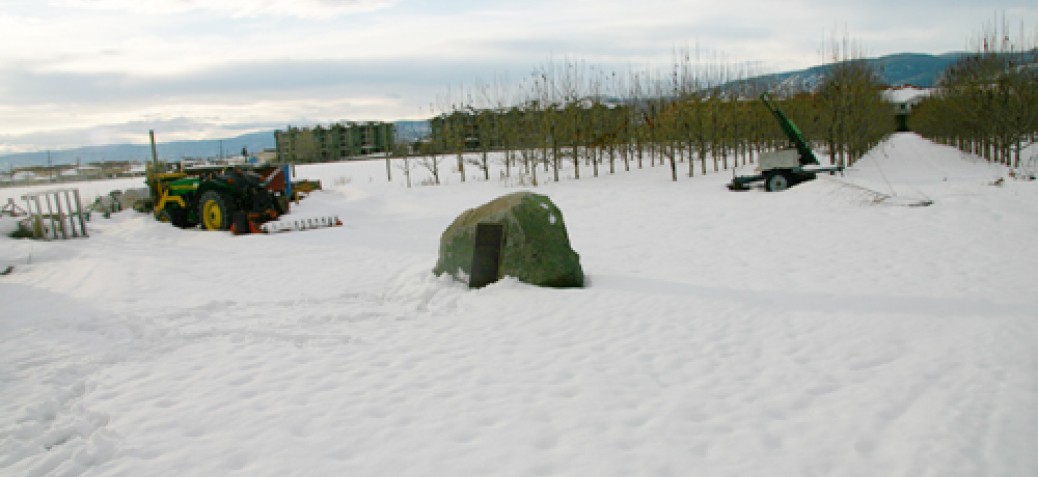Pandosy Mission Cemetery
Place Description
The Pandosy Mission Cemetery is an early burial ground located in a rural farm setting approximately 300 metres west of the restored buildings of the Oblate Mission on Benvoulin Road, and covering an area of almost 400 square metres. The level, treeless grassed terrain was farmed for a number of years, and no early headstones, grave markers or cemetery features have survived above ground. Excavations have revealed thirteen sub-surface grave features. A stone marker and plaque commemorates the cemetery, which includes the grave of Father Pandosy. The site is reached by an easement that crosses private land. The Father Pandosy Mission has been designated as a British Columbia Provincial Heritage Site.
Heritage Value
The Pandosy Mission Cemetery is extremely significant as the location of the original cemetery for the Pandosy Mission and Immaculate Conception Mission Church, as well as being the location of the remains of pioneer Oblate missionary Father John Charles Felix Adolph Pandosy (1824-1891).
This was the first European burial ground in the region, and was likely in place as early as the 1860s. The location of the cemetery in relation to the Mission site was deliberate, as it was common practice to locate burials away from the dwellings. It appears to have been used until about 1906, by which time the Catholic Cemetery on Casorso Road was established. A church at the site, which was built in 1894, was demolished in 1912. The Mission land was sold, and the owner maintained the site until the enclosing fence fell down due to lack of maintenance in about 1922. At that time, the land was ploughed for agricultural production. The exact location of the cemetery was unknown until 1983 and once the location was pinpointed on this rural farmsite it was acquired by the Roman Catholic Church. Archaeological excavations in 1983 indicated that the remains of thirteen individuals interred at the site: eleven burials face to the northeast and two, presumed to be priests, are on an east-west axis. The site is commemorated with a granite boulder mounted with a brass plaque that dedicates the sites to the memory of the Pandosy settlers, the First Nations who inhabited the land and the pioneer families who first settled in Kelowna. The grave marker faces to the southeast, the direction of the Father Pandosy Mission.
The Pandosy Mission Cemetery is additionally valued for its association to the Father Pandosy Mission and the Oblates of Mary Immaculate. Father Pandosy and Father Pierre Richard were sent by the Oblates of Mary Immaculate Mission in 1859 to establish the first non-Native settlement in the Okanagan Valley in order to ‘preach the gospel to the poor’. Also buried here is Father Florimond Gendre, the first principal of the Sisters of Saint Ann in Vancouver. The site was established in 1860 and originally covered over 809 hectares with the main settlement centred parallel to Mission Creek. Over the next thirty years, the mission constructed the area’s first school, a successful farming and cattle ranch and built the first church, while providing a vital link for remote First Nations communities to non-Native society. The mission was in operation until 1902, when the land was sold to Father Eumelin and later in 1908 to the Central Okanagan Land Company. The buildings remained in disuse and disrepair until 1954 when a movement to restore the buildings occurred. This property is now owned by the Roman Catholic Bishop of Nelson and is managed by the Okanagan Historical Society.
Character Defining Elements
Key elements that define the heritage character of the Pandosy Mission Cemetery include its:
- location in relation to the Pandosy Mission site, on a rural farm property on Gordon Avenue in the South Pandosy Sector in Kelowna
- flat grassed terrain
- granite boulder marker, with a commemorative brass plaque, facing southeast towards Pandosy Mission
- subsurface remains of a number of individuals buried at the site, including Father Pandosy, Father Pierre Richard and Florimond Gendre




